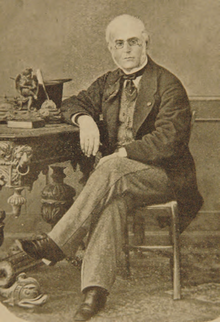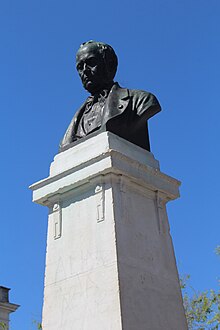| CouncillorBernardino António Gomes Jr.CavTE ComC ComSE | |
|---|---|
 | |
| First Physician of the Royal Chamber | |
| In office January 1864 – April 1877 | |
| Monarch | Luís I of Portugal |
| Preceded by | The Baron of Silveira |
| Succeeded by | José Eduardo de Magalhães Coutinho |
| Personal details | |
| Born | (1806-09-22)22 September 1806 Santa Marinha do Outeiro, Lisbon, Portugal |
| Died | 8 April 1877(1877-04-08) (aged 70) São José, Lisbon, Portugal |
| Spouse |
Maria Leocádia Fernandes Tavares de Barros
(m. 1837; died 1854) |
| Alma mater | University of Coimbra Faculté de Médecine de Paris |
| Scientific career | |
| Fields | Medicine, Anaesthesiology |
| Institutions | Royal Naval Hospital Saint Joseph's Hospital |
| Thesis | Dissertation sur les vers plats articulés qui existent chez l'homme, ou considérations sur la détermination de leurs espèces, des maladies qu'ils occasionnent, et du traitement qu'ils convient mieux de leur opposer (1831) |
Bernardino António Gomes CavTE ComC ComSE (22 September 1806 – 8 April 1877) was a Portuguese physician and scientist. He is perhaps most widely remembered for his pioneering work in Portugal in the field of anaesthesiology, as the first physician in the country to use chloroform in a surgical procedure (on 12 January 1848, during a knee tumorectomy); he is also credited with the popularization of the use of creosote and of the first ether inhalers.
Biography
Bernardino António Gomes was the son of noted physician, pioneering dermatologist, chemist, and botanist of name, Bernardino António Gomes Sr. (1768–1823), and his wife Leonor Violante Rosa Mourão (1775–1864). He was baptised on 9 October 1806, in the parish of Santa Engrácia, Lisbon.
He first studied Mathematics in the University of Coimbra, switching to Medicine after obtaining the first degree. He interrupted his studies in 1828, with the start of the Portuguese Civil War; he joined the Academic Battalion but soon after, judging, like many did, the Liberal cause lost when King Miguel I seized the throne, he departed to Paris, where he completed his medical studies in 1831. At the invitation of the Marquis of Palmela, who was part of the Liberal government-in-opposition, Bernardino António Gomes rejoined the Liberal forces in Terceira Island in the Azores: he would later take part in the Landing at Mindelo, the turning point of the Civil War, and was in the besieged resistance at the Siege of Porto (during which he provided medical assistance due to a cholera outbreak). As the Constitutional Monarchy was finally established, he filled the positions of Director of the Royal Naval Hospital, Chairman of the Council for Naval Health, physician of Saint Joseph's Hospital, and Professor at the Lisbon Medical-Surgical School (Chair of Materia Medica from 1837 to 1857).

Bernardino António Gomes distinguished himself during the yellow fever and cholera epidemics that ravaged the country in the 1850s. He was sent as a national delegate to the third of the International Sanitary Conferences (in Constantinople, 1866); in opposition to Pettenkofer's anti-contagionism that dominated the scientific thinking of the conference, Bernardino António Gomes was a staunch defender of the theory of contagion and considered it advisable to ban all maritime communication to quell the ongoing cholera pandemic that had begun in the Ganges Delta, "to combat the scourge in the very countries in which it is born or, at least, to halt its progress as near as possible to its original home" (measures that were opposed, notably, by the delegates from the United Kingdom).
In 1858, Bernardino António Gomes became embroiled in a heated pamphlet war with the Duke of Saldanha, one of the leading promoters of homeopathy and other systems of alternative medicine like mesmerism or the "Raspail method" in the country. The tone of the replies quickly escalated, with Bernardino António Gomes protesting that the Duke was hardly an authority when he clearly had so little baggage and was armed with such lacking medical literature — something, he wrote, that did not stop him from openly casting doubt on science and making the public mistrustful of medical practitioners.
He was appointed First Physician of the Royal Chamber in 1864, by King Luís I, following the death of Francisco Elias Rodrigues da Silveira, 1st Baron of Silveira; Gomes refused the title of Baron that was customarily bestowed upon those filling that position at court. Previously, he had already been a personal physician to his brother and predecessor King Peter V — Bernardino António Gomes was responsible for conducting and publicising the results of the King's autopsy in 1861, when tensions were running high as three deaths in quick succession within the Royal Family (the King, Infante John, Duke of Beja and Infante Ferdinand) had made the public suspicious of foul play and threaten to mutiny; he attributed the deaths to typhoid fever.
On two different occasions, in 1843–4 and 1864–6, Bernardino António Gomes served as President of the Lisbon Society of Medical Sciences.
As a natural historian, Bernardino António Gomes published an exhaustive review of the fossil flora of the Carboniferous systems in Portugal (1865), and was a contributor in the Catalogus Plantarum Horti Botanici Medico-Cirurgicae Scholae Olisiponensis (1851). He also oversaw the committee in charge of creating the 1876 Portuguese Pharmacopoeia, the first time the country's official pharmaceutical reference work was drawn up by a committee of select physicians and chemists.
He married Maria Leocádia Fernandes Tavares de Barros (1818–1854) in the parish of Encarnação, Lisbon, on 14 October 1837. They were the parents of botanist, forestry engineer, and Lazarite priest Bernardino António de Barros Gomes (1839–1910), and statesman Henrique de Barros Gomes (1843–1898).
The standard author abbreviation B.A.Gomes is used to indicate this person as the author when citing a botanical name.
Distinctions
National orders
 Knight of the Order of the Tower and Sword
Knight of the Order of the Tower and Sword Commander of the Order of Christ
Commander of the Order of Christ Commander of the Order of Saint James of the Sword
Commander of the Order of Saint James of the Sword
Foreign orders
 Officer of the Legion of Honour (France)
Officer of the Legion of Honour (France) Commander of the Order of Saints Maurice and Lazarus (Italy)
Commander of the Order of Saints Maurice and Lazarus (Italy) Grand Cross of the Order of Isabella the Catholic (Spain)
Grand Cross of the Order of Isabella the Catholic (Spain)
References
- ^ Pereira e Sousa, F. (1890). "Dr. Bernardino Antonio Gomes". A Imprensa (in Portuguese). No. 65. Lisbon. pp. 132–134. Retrieved 18 October 2020.
- ^ Lopes, Alfredo Luiz (1890). O Hospital de Todos os Santos hoje denominado de S. José: Contribuições para a Historia das Sciencias Medicas em Portugal [All Saints' Hospital, today called of Saint Joseph: Contributions for the History of Medical Sciences in Portugal] (in Portuguese). Lisboa: Imprensa Nacional. pp. 72–74.
- ^ Livro de Registo de Baptismos 1806/1818 (fl. 19 v.), Paróquia de Santa Engrácia, Lisboa – Arquivo Nacional da Torre do Tombo
- Howard-Jones, Norman (1975). "The scientific background of the International Sanitary Conferences (1851–1938)". History of International Public Health. 1. hdl:10665/62873. Retrieved 18 October 2020.
- Garnel, Maria Rita Lino (2009). "Portugal e as Conferências Sanitárias Internacionais (em torno das epidemias oitocentistas de cholera-morbus)" [Portugal and the International Sanitary Conferences (concerning the 19th-century epidemics of cholera-morbus)]. Revista de História da Sociedade e da Cultura (in Portuguese). 9: 229–251. doi:10.14195/1645-2259_9_9. ISSN 1645-2259. Retrieved 18 October 2020.
- Pombo, Maria Dulce (2010). Modelos terapêuticos em movimento no Portugal do século XIX: actores, discursos e controvérsias [Therapeutic models in motion in 19th-century Portugal: players, discourses, and controversies] (Master's degree). ISCTE – Instituto Universitário de Lisboa, Escola de Sociologia e Políticas Públicas. hdl:10071/3836. Retrieved 18 October 2020.
- Almeida, Maria Antónia Pires de (2014). "Combatendo epidemias: Bernardino António Gomes, Sousa Martins, Ricardo Jorge, Câmara Pestana, Almeida Garrett, Fernando da Silva Correia". In Rollo, Maria Fernanda; Nunes, Maria de Fátima; Esperança Pina, Madalena; Queiroz, Maria Inês (eds.). Espaços e Actores da Ciência em Portugal (XVIII-XX) (in Portuguese). Lisboa: Caleidoscópio. pp. 309–326. hdl:10071/12242. ISBN 9789896582746.
- ^ "Bernardino Gomes (1843/1844 e 1864/1866)" (in Portuguese). Sociedade das Ciências Médicas de Lisboa. Retrieved 17 October 2020.
- Conceição, J.; Pita, J.R.; Estanqueiro, M.; Lobo, J.S. (2009). "As farmacopeias portuguesas e a saúde pública" [Portuguese pharmacopoeias and public health] (PDF). Acta Farmacêutica Portuguesa (in Portuguese). 3 (1): 47–65. ISSN 2182-3340. Retrieved 18 October 2020.
- Livro de Registo de Casamentos 1834/1848 (fl. 137), Paróquia da Encarnação, Lisboa – Arquivo Nacional da Torre do Tombo
- International Plant Names Index. B.A.Gomes.
External links
 Media related to Bernardino António Gomes Jr. at Wikimedia Commons
Media related to Bernardino António Gomes Jr. at Wikimedia Commons
- 1806 births
- 1877 deaths
- 19th-century Portuguese physicians
- Commanders of the Order of Christ (Portugal)
- Commanders of the Order of Saint James of the Sword
- Commanders of the Order of Saints Maurice and Lazarus
- Court physicians
- Knights Grand Cross of the Order of Isabella the Catholic
- Officers of the Legion of Honour
- Physicians from Lisbon
- Scientists from Lisbon